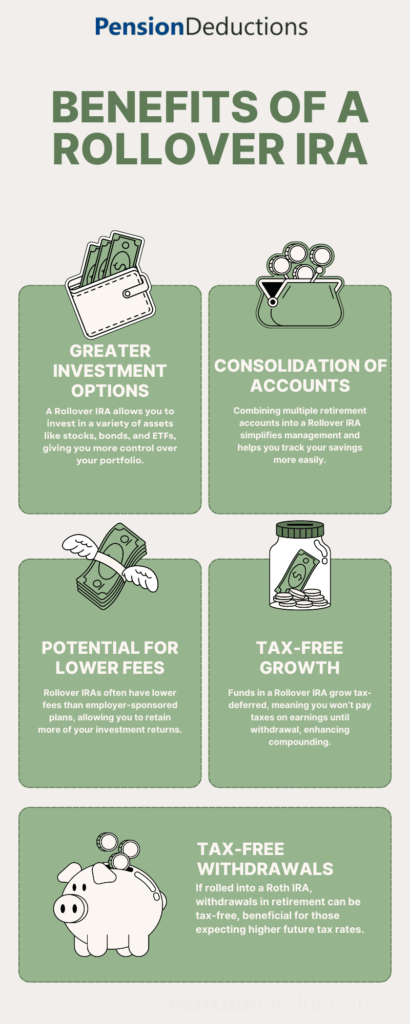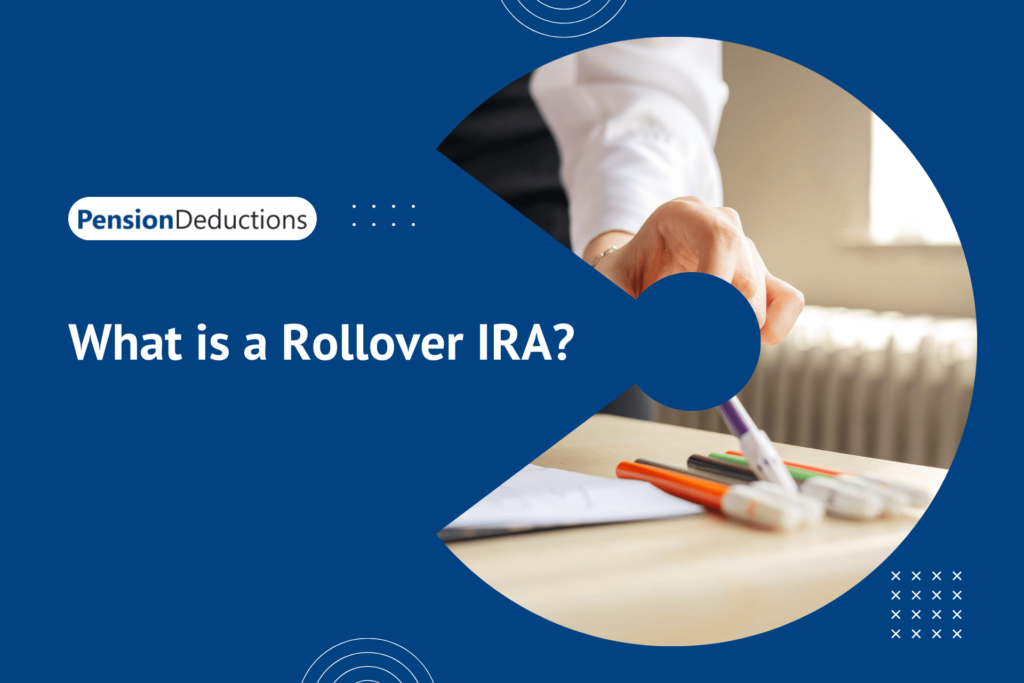Rollover IRA. Types, Rules, and Benefits.
What is a Rollover IRA?
The purpose of a Rollover IRA is to help individuals maintain control over their retirement funds by consolidating assets into a single account. This strategy often simplifies account management and investment choices while maintaining the tax-advantaged status of retirement savings.
Types of Rollover IRAs
Traditional Rollover IRA
The Traditional Rollover IRA is the most common type. It allows you to transfer funds from a traditional 401(k) or 403(b) into a traditional IRA without triggering taxes or penalties. The funds continue to grow tax-deferred, and you’ll pay taxes only when you withdraw during retirement.
Roth Rollover IRA
A Roth Rollover IRA involves moving funds from a traditional 401(k) or other employer-sponsored plans into a Roth IRA. Unlike the traditional Rollover IRA, you will have to pay taxes on the rolled-over amount upfront. However, the benefit is that qualified withdrawals in retirement are entirely tax-free.
Direct vs. Indirect Rollover IRAs
Direct Rollover: In a direct rollover, your funds are transferred directly from your old employer-sponsored plan into a Rollover IRA. No taxes are withheld, and the process is straightforward.
Indirect Rollover: With an indirect rollover, you receive the funds from your retirement account and are responsible for depositing them into a Rollover IRA within 60 days. Be aware that taxes may be withheld, and failure to deposit the funds within the specified timeframe could result in penalties and taxes.
Schedule a Free Consultation Now!
Key Rules for Rollover IRAs
60-Day Rule
When doing an indirect rollover, you have 60 days from the day you receive your retirement plan funds to deposit them into a Rollover IRA. If you miss the deadline, the IRS will treat the withdrawal as income, subjecting it to taxes and potential penalties.
One Rollover Per Year Rule
The IRS limits you to one indirect rollover between IRAs within a 12-month period. This rule does not apply to direct rollovers, which means you can transfer funds from an employer-sponsored plan to a Rollover IRA multiple times without penalty.
No Contribution Limits for Rollovers
Unlike regular IRA contributions, which are capped annually ($6,500 in 2024 or $7,500 for those aged 50 and older), rollovers are not subject to these limits. You can roll over as much as your previous employer-sponsored plan holds into your new Rollover IRA.
Avoiding Required Minimum Distributions (RMDs)
If you are 72 or older, you are required to take RMDs from certain retirement accounts, including traditional IRAs. However, funds rolled into a Rollover IRA are still subject to these RMD rules, so it’s essential to plan your rollovers before reaching the age where RMDs are required.
Benefits of a Rollover IRA
Greater Investment Options
When you roll over your funds into an IRA, you open up a much broader range of investment choices compared to a typical 401(k) or 403(b). With a Rollover IRA, you can invest in individual stocks, bonds, ETFs, mutual funds, and more.
Consolidation of Accounts
Many individuals switch jobs multiple times during their careers, leading to several employer-sponsored retirement accounts. By rolling over these accounts into a single Rollover IRA, you can streamline account management, making it easier to monitor your overall retirement savings and track your financial goals.
Potential for Lower Fees
Employer-sponsored retirement plans often come with higher fees or limited investment options. By moving your funds into a Rollover IRA, you may have access to lower-cost investment options, which can significantly reduce the fees you pay over time.
Tax-Free Growth
Like other retirement accounts, funds within a Rollover IRA grow tax-deferred. This means that you won’t pay taxes on your gains until you withdraw the funds in retirement, allowing your investments to compound over time.
Tax-Free Withdrawals (Roth Rollover IRA)
If you choose to roll your funds into a Roth IRA, you will enjoy the benefit of tax-free withdrawals in retirement, provided you meet the qualifying conditions (such as holding the account for at least five years). This can be a huge advantage, especially if you expect to be in a higher tax bracket during your retirement years.

Common Mistakes to Avoid with Rollover IRAs
Missing the 60-Day Deadline
Failing to complete an indirect rollover within the 60-day window can result in taxes and penalties. Opt for a direct rollover whenever possible to avoid this issue.
Ignoring Required Minimum Distributions
If you roll over funds into a traditional Rollover IRA after age 72, you must still take RMDs, which are taxable. Be mindful of this rule when considering your rollover options.
Not Considering the Roth Conversion
If you anticipate being in a higher tax bracket in retirement, converting a traditional Rollover IRA to a Roth IRA could be a smart tax-saving strategy. Consult with a tax advisor to evaluate whether this move fits your long-term retirement goals.
Is a Rollover IRA Right for You?
Conclusion
If you’re considering a Rollover IRA, reach out to a financial advisor to explore your options and create a customized strategy that helps you maximize your retirement savings.
SHARE THIS POST
Discover the 3 retirement rule changes in 2025, including contribution limits, RMD updates, and automatic portability. Plan smarter today!
Year-end financial planning in the USA helps optimize retirement savings, reduce taxes, and secure your future with proactive strategies.
Discover the top retirement savings tips for individuals aged 55 to 64. Learn how to maximize your 401(k), IRAs, Social Security, and pension benefits while planning for a secure future.
Explore the types of Individual Retirement Accounts and learn how each can enhance your retirement savings and tax benefits for a secure future.


